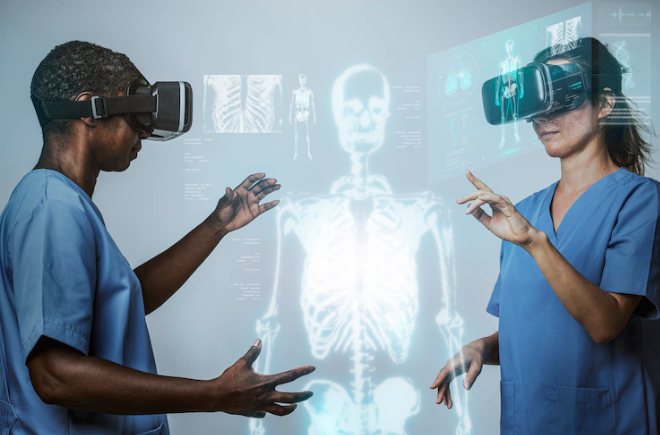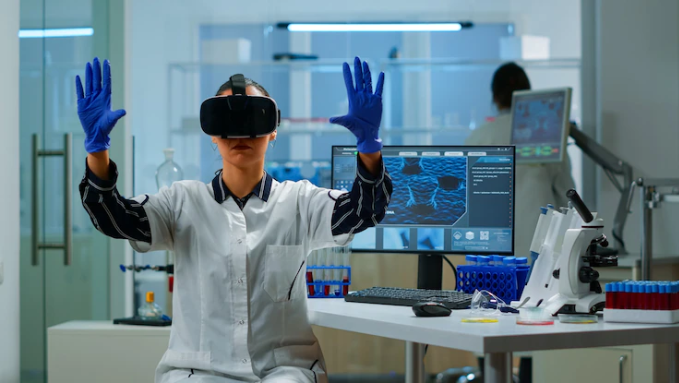Virtual reality is a fantastic technology that is slowly taking over different sectors. VR simulators offer a realistic experience that immerses you in a completely different world. This technology has extended its wings from entertainment to various industries such as healthcare, education, and so on.
The healthcare industry is revolutionizing by integrating VR into patient care and medical training. With the popularity of VR simulators in the healthcare industry, many developers and companies are on their way to learning how to develop a VR surgeon simulator, VR medical training simulator, and many more.
VR simulators are taking the healthcare industry to the next level with their interactive environment and realistic scenarios. This blog post will take you through some of the ways VR is changing the healthcare industry. So, let’s begin.
Medical Professionals Training
Training is an essential part of every medical professional’s life. It allows them to sharpen their skills and knowledge to provide the best possible care to their patients. Traditionally, medical professionals were trained by using static textbooks and 2D images. This method was not very effective as it did not provide a realistic experience.
When it comes to training medical professionals, VR simulators provide a huge advantage. Currently, there are many VR simulators available in the market that can be used for medical training. Some popular VR simulators used for medical training are UbiSim, Healthcare Scholars, and VR Patients.
VR simulators allow students to get familiar with the hospital environment and procedures without putting any patient’s life at risk. For example, if a medical student needs to learn how to place a central line, they can do so by using a VR simulator. It will save the life of a patient and give the student the confidence to perform the procedure in a real-life situation.
Mentally Preparing Patients for Treatment
Complex treatments often scare patients. It is because they are not aware of what to expect and how the treatment will be performed. Taking them through the whole procedure can be helpful. VR simulator is the perfect tool for this purpose.
A VR immersive experience can help the patient understand the procedure, the hospital environment, and what they need to do. It will help them feel mentally prepared for the treatment. For example, a patient who is scheduled for surgery can be taken through the VR hospital environment to know what to expect on the day of their surgery.
It will help them feel less anxious and more prepared for the treatment. The VR simulator development team develops well-designed simulators to provide an immersive experience to the patients. Project managers, VR developers, Java developers with comprehensive knowledge of Hadoop developer duties and skills, and quality assurance engineers work together to create stunning equipment.
Helping Patients Cope Phobias
Phobias are a type of anxiety disorder that can be debilitating. It can make it difficult for the person to go about their daily life. Virtual reality has a perfect solution for this. Phobias can be treated with the help of VR therapy. It helps the person face their fear in a controlled and safe environment.
VR therapy can help doctors treat different phobias such as fear of heights, fear of public speaking, fear of flying, etc. The patient is exposed to the environment that triggers their anxiety. But they are in a safe space where they can’t be harmed. VR simulators are also a great invention for coping with post-traumatic stress disorder. It can help the person relive their trauma in a safe and controlled environment. It will help them to process their trauma and eventually overcome it.
The therapist can gradually expose the person to the thing they are afraid of and help them cope with their fear. For example, a person who fears height can be gradually exposed to heights in a VR simulator. It will help them to overcome their fear and live a normal life.
Helping Patients Cope with Pain
Experiencing pain in a hospital can be difficult for patients. It can make their hospital stay even more difficult. VR analgesia is a new way to help patients cope with pain. It is a non-invasive and drug-free method of pain management.
Some VR simulators work by distracting the patient from their pain. It does this by providing them with a stimulating experience. It will help the person focus on something other than their pain. For example, a patient can be given a VR headset to distract from their pain.
Other VR simulators work by providing a relaxing and soothing environment. It will help to relax the person and reduce their pain. For example, a patient can be given a VR headset to take them to a relaxing beach. It will help to reduce their pain and make their hospital stay more bearable.
Boosting Recovery in Physical Therapy
Physical therapy helps to effectively improve the strength, flexibility, and range of motion of patients. VR can contribute to the physical therapy field by providing a fun and stimulating environment.
It will help to motivate the patients to do their exercises. It can also help to make physical therapy more effective. For example, a patient can be given a VR headset to play a game that will help them to improve their range of motion.
Many companies are developing VR simulators that can offer gamified physical therapy. It will help make the therapies more effective as the patient will be more engaged.




